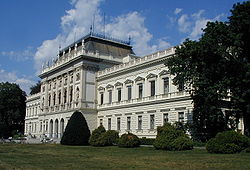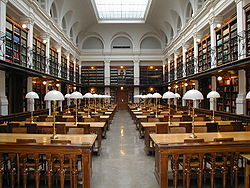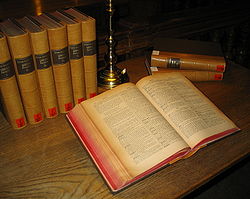
University Library of Graz
Encyclopedia
The University Library of Graz
is the largest scientific and public library in Styria and the third largest in Austria
. It holds the right of legal deposit
. It is part of the Karl Franzens University of Graz and consists of the main library, two faculty libraries (for law and social and economic sciences, and for theology) and several branch libraries and is open to the public.


. as a Jesuit University, thus the library came into the status of a university library. It grew rapidly because many books got transferred from monasteries to Graz and because of donations and continuous purchases. The university was more or less a theological faculty, and the library's main focus in purchasing books was also theology - but not necessarily Catholic theology. Natural sciences were well represented due to the influence of the mathematician Paul Guldin, who was one of the university professors. When the Jesuit order was abolished in 1773 the university became a state university.
in 1782 by the emperor Josef II. Its collections increased nonetheless.

 The second half of the 20th century is predominantly characterized by constructional changes and progressive decentralisation. In 1950 both stacks situated edgeways behind the reading room got an annex in the south-east. 1970 a new building (of no architectural value whatsoever) was added-on to the old house with a new entrance and hall. From 1994 to 1996 the ReSoWi-Library which accommodates the Law and Social and Economic Sciences Libraries was built. At the same time another building was erected directly attached to the library's original front leaving it unaltered. This addition is exclusively used by the library. Additionally, there were several branch libraries opened in some distance to the main library, e. g. in the Universitätszentrum Wall situated in Merangasse 70. In 1996, a media library for visual media was installed. As a consequence of the university-splitting in 2004, the medical branches became an autonomous university library. Together with the University Libraries of Vienna and Innsbruck Graz has been assuming control of the establishment of national and international consortia installed in order to use electronic journals and books in cooperation and thus more cost-effectively in 1998. On July 1, 2005 the "Cooperation of e-media in Austria" was constituted. The University Library of Graz authoritatively participates in the project Austrian Literature Online, the digitisation of Austrian literature.
The second half of the 20th century is predominantly characterized by constructional changes and progressive decentralisation. In 1950 both stacks situated edgeways behind the reading room got an annex in the south-east. 1970 a new building (of no architectural value whatsoever) was added-on to the old house with a new entrance and hall. From 1994 to 1996 the ReSoWi-Library which accommodates the Law and Social and Economic Sciences Libraries was built. At the same time another building was erected directly attached to the library's original front leaving it unaltered. This addition is exclusively used by the library. Additionally, there were several branch libraries opened in some distance to the main library, e. g. in the Universitätszentrum Wall situated in Merangasse 70. In 1996, a media library for visual media was installed. As a consequence of the university-splitting in 2004, the medical branches became an autonomous university library. Together with the University Libraries of Vienna and Innsbruck Graz has been assuming control of the establishment of national and international consortia installed in order to use electronic journals and books in cooperation and thus more cost-effectively in 1998. On July 1, 2005 the "Cooperation of e-media in Austria" was constituted. The University Library of Graz authoritatively participates in the project Austrian Literature Online, the digitisation of Austrian literature.
See also History of Graz University Library
school
 The number of books in the old library is historically uncertain. According to one source there were 10.000 volumes in 1773, and according to another one 42.000 in 1776. Another similarly unreliable source counts 50.000 volumes or fewer for the year 1839. A survey in the year 1860 states 38.000 printed works, many of them had more than one volume. In 1879 the library owned about 100.000 volumes, in the first year of the 20th century 200.000. At the turn of the millennium, the actual stocks were almost 3 million printed books, more than 2000 manuscripts, about 1200 incunabula, bequests of many scholars and about 1400 current periodicals.
The number of books in the old library is historically uncertain. According to one source there were 10.000 volumes in 1773, and according to another one 42.000 in 1776. Another similarly unreliable source counts 50.000 volumes or fewer for the year 1839. A survey in the year 1860 states 38.000 printed works, many of them had more than one volume. In 1879 the library owned about 100.000 volumes, in the first year of the 20th century 200.000. At the turn of the millennium, the actual stocks were almost 3 million printed books, more than 2000 manuscripts, about 1200 incunabula, bequests of many scholars and about 1400 current periodicals.
manuscripts are the five oldest Georgian scripts (7th to 11th century) found in the Saint Catherine's Monastery at the foot of Mount Sinai
. Some of the most important paper manuscripts are Johannes Kepler
's letters to Paul Guldin
. 42 papyrus
-manuscripts from Oxyrhynchos and Hibeh must also be mentioned. They were found by the British Egypt Exploration Society between 1896 and 1907 and entered into the library's possessions as quid pro quo for the city's financial support of the Society's excavations. Today, the greatest part of these findings is located in the Ashmolean Museum
in Oxford
, the British Museum
in London
and the Egyptian Museum
in Cairo
.
Graz
The more recent population figures do not give the whole picture as only people with principal residence status are counted and people with secondary residence status are not. Most of the people with secondary residence status in Graz are students...
is the largest scientific and public library in Styria and the third largest in Austria
Austria
Austria , officially the Republic of Austria , is a landlocked country of roughly 8.4 million people in Central Europe. It is bordered by the Czech Republic and Germany to the north, Slovakia and Hungary to the east, Slovenia and Italy to the south, and Switzerland and Liechtenstein to the...
. It holds the right of legal deposit
Legal deposit
Legal deposit is a legal requirement that a person or group submit copies of their publications to a repository, usually a library. The requirement is mostly limited to books and periodicals. The number of copies varies and can range from one to 19 . Typically, the national library is one of the...
. It is part of the Karl Franzens University of Graz and consists of the main library, two faculty libraries (for law and social and economic sciences, and for theology) and several branch libraries and is open to the public.

History

The library of the Jesuit university
The UB Graz owes its origin to the Counter-Reformation. Since 1571 the Jesuits had been pushing the re-catholization in the predominantly Protestant city of Graz according to the wishes of the Archduke Charles II of Austria. For that reason a Jesuit college with a school and a library were founded next to the cathedral in 1573. In 1585 this school was confirmed by Pope Gregory XIIIPope Gregory XIII
Pope Gregory XIII , born Ugo Boncompagni, was Pope from 1572 to 1585. He is best known for commissioning and being the namesake for the Gregorian calendar, which remains the internationally-accepted civil calendar to this date.-Youth:He was born the son of Cristoforo Boncompagni and wife Angela...
. as a Jesuit University, thus the library came into the status of a university library. It grew rapidly because many books got transferred from monasteries to Graz and because of donations and continuous purchases. The university was more or less a theological faculty, and the library's main focus in purchasing books was also theology - but not necessarily Catholic theology. Natural sciences were well represented due to the influence of the mathematician Paul Guldin, who was one of the university professors. When the Jesuit order was abolished in 1773 the university became a state university.
The public university library
In 1775 the university was officially founded again by a decree and was put under national control together with its library. However, most of the imperial officials who administrated the university as well as the library were former Jesuits. In 1781 the library was re-opened after several adjustments of its new premises and became open for the public for the first time. Unfortunately, the 28 volume library catalogue was untraceable, it might have been taken away or destroyed by some glowering Jesuits and has never been detected until today. The considerable increase of books from monasteries aggravated the chaos.The lyceum library
As well as several other universities the University of Graz was downgraded to the status of lyceumLyceum
The lyceum is a category of educational institution defined within the education system of many countries, mainly in Europe. The definition varies between countries; usually it is a type of secondary school.-History:...
in 1782 by the emperor Josef II. Its collections increased nonetheless.

The re-established University Library
On the 19. April 1827, after 45 years, the old rights were re-confirmed by the emperor Francis I of Austria. Since then the university mentions both founders in its name "Karl-Franzens-Universität Graz". Adjunctive to the re-installation was a requirement: the university must not cause any additional costs to the state. Therefore it stayed dependent on donations and bequests. Only when the number of personnel was raised from 3 to 6 and the endowment from 830 to 4000 guilder in 1870, the university could again accomplish its tasks properly.From the relocation to the end of World War II
Due to the limited space at the city centre, a new complex of buildings was erected in the periphery (present day Geidorf) in 1891. The various buildings were opened at different times. Between September 9 to 22, 1895 the library moved 135.000 volumes to the main building of the new university. Its further development in stock increase and administration suffered heavy setbacks in both world wars. 60.000 volumes were evacuated to save them from air raids in 1944. On October 22, 1945 the library was re-opened. 4.500 volumes (including 200 incunabula) had been destroyed during World War II.Latest developments

See also History of Graz University Library
school
School
A school is an institution designed for the teaching of students under the direction of teachers. Most countries have systems of formal education, which is commonly compulsory. In these systems, students progress through a series of schools...
Staff
When the library was taken over by the state, it got two employees: the director and a library servant. At the beginning of the 20th century the staff numbered 17, 8 of them being scientific civil servants. At the turn of the millennium the library staff had grown to 120.| The directors of the University Library of Graz under state administration | |
| 1773-1774 | Josef Bardarini (1708–1791), professor of theology and philosophy, rector of the university |
| 1775–1778 | Richard Tecker (1723–1798), professor of dogmatics |
| 1778–1783 | Franz de Paula Tomicich (1729-), professor of ecclesiastical law, rector of the university |
| 1783–1797 | Augustin Herz |
| 1798–1814 | Josef Alois Jüstel (1765–1832), professor of moral theology, rector of the university |
| 1817–1832 | Markus Sandmann (1764–1832), author |
| 1833–1852 | Johann Krausler (-1852) |
| 1853–1861 | Leopold Michelitsch |
| 1861–1866 | Karl Kreutzer |
| 1866–1880 | Ignaz Tomaschek |
| 1880–1895 | Alois Müller (1835–1901), specialist for Hebrew studies |
| 1895–1903 | Wilhelm Haas (1842–1918), afterwards director of the University Library of Vienna |
| 1903–1910 | Anton Schlossar (1849–1942) |
| 1910–1919 | Johannes Peisker (1851–1933), later professor of social and economic history in Prague Prague Prague is the capital and largest city of the Czech Republic. Situated in the north-west of the country on the Vltava river, the city is home to about 1.3 million people, while its metropolitan area is estimated to have a population of over 2.3 million... |
| 1919–1924 | Ferdinand Eichler (1863–1945), professor of library sciences |
| 1924–1933 | Jakob Fellin (1869–1951) |
| 1934–1945 | Franz Gosch (1884–1952) |
| 1945–1953 | Wolfgang Benndorf (1901–1959) |
| 1954–1971 | Erhard Glas (1906–1992) |
| 1972–1988 | Franz Kroller (1923–2000) |
| 1989–2006 | Sigrid Reinitzer (1941-) |
| 2004- | Werner Schlacher (1955-) |
Holdings

Special collections
The Special Collections Department holds all manuscripts and works printed up to 1900. Some of the most notable parchmentParchment
Parchment is a thin material made from calfskin, sheepskin or goatskin, often split. Its most common use was as a material for writing on, for documents, notes, or the pages of a book, codex or manuscript. It is distinct from leather in that parchment is limed but not tanned; therefore, it is very...
manuscripts are the five oldest Georgian scripts (7th to 11th century) found in the Saint Catherine's Monastery at the foot of Mount Sinai
Mount Sinai
Mount Sinai , also known as Mount Horeb, Mount Musa, Gabal Musa , Jabal Musa meaning "Moses' Mountain", is a mountain near Saint Catherine in the Sinai Peninsula of Egypt. A mountain called Mount Sinai is mentioned many times in the Book of Exodus in the Torah and the Bible as well as the Quran...
. Some of the most important paper manuscripts are Johannes Kepler
Johannes Kepler
Johannes Kepler was a German mathematician, astronomer and astrologer. A key figure in the 17th century scientific revolution, he is best known for his eponymous laws of planetary motion, codified by later astronomers, based on his works Astronomia nova, Harmonices Mundi, and Epitome of Copernican...
's letters to Paul Guldin
Paul Guldin
Paul Guldin was a Swiss Jesuit mathematician and astronomer. He discovered the Guldinus theorem to determine the surface and the volume of a solid of revolution. This theorem is also known as Pappus–Guldinus theorem and Pappus's centroid theorem, attributed to Pappus of Alexandria...
. 42 papyrus
Papyrus
Papyrus is a thick paper-like material produced from the pith of the papyrus plant, Cyperus papyrus, a wetland sedge that was once abundant in the Nile Delta of Egypt....
-manuscripts from Oxyrhynchos and Hibeh must also be mentioned. They were found by the British Egypt Exploration Society between 1896 and 1907 and entered into the library's possessions as quid pro quo for the city's financial support of the Society's excavations. Today, the greatest part of these findings is located in the Ashmolean Museum
Ashmolean Museum
The Ashmolean Museum on Beaumont Street, Oxford, England, is the world's first university museum...
in Oxford
Oxford
The city of Oxford is the county town of Oxfordshire, England. The city, made prominent by its medieval university, has a population of just under 165,000, with 153,900 living within the district boundary. It lies about 50 miles north-west of London. The rivers Cherwell and Thames run through...
, the British Museum
British Museum
The British Museum is a museum of human history and culture in London. Its collections, which number more than seven million objects, are amongst the largest and most comprehensive in the world and originate from all continents, illustrating and documenting the story of human culture from its...
in London
London
London is the capital city of :England and the :United Kingdom, the largest metropolitan area in the United Kingdom, and the largest urban zone in the European Union by most measures. Located on the River Thames, London has been a major settlement for two millennia, its history going back to its...
and the Egyptian Museum
Egyptian Museum
The Museum of Egyptian Antiquities, known commonly as the Egyptian Museum, in Cairo, Egypt, is home to an extensive collection of ancient Egyptian antiquities. It has 120,000 items, with a representative amount on display, the remainder in storerooms....
in Cairo
Cairo
Cairo , is the capital of Egypt and the largest city in the Arab world and Africa, and the 16th largest metropolitan area in the world. Nicknamed "The City of a Thousand Minarets" for its preponderance of Islamic architecture, Cairo has long been a centre of the region's political and cultural life...
.
Source
- Manuela Reiter and Sigrid Reinitzer: "University Library of Graz". In: International Dictionary of Library History. Vol. 2. Chicago, London 2001.
External links
homepage- History virtual trip Just click into the pictures to chose the path followed library catalogue Special collections

